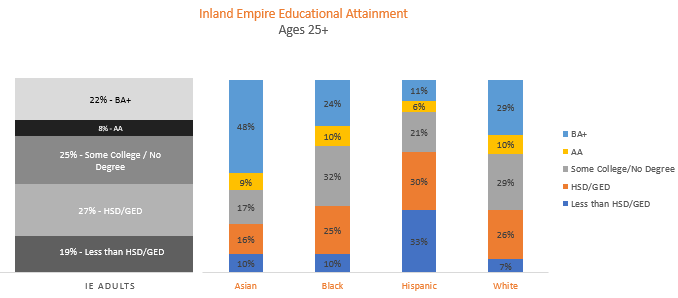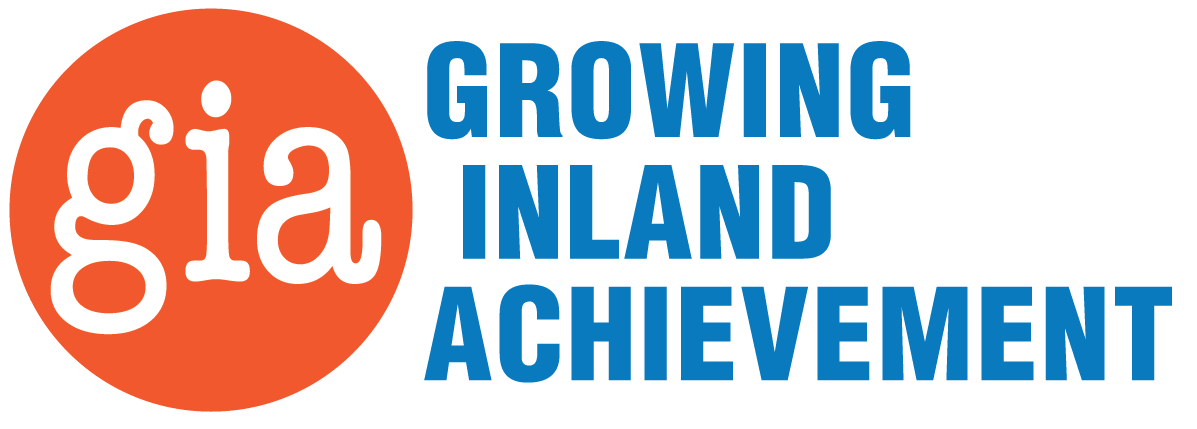action network teams
Returning Adults & Professional Education
The Returning Adults & Professional Education (RE) Action Network Team (ANT) convenes the third Thursday of every month to create and carry-out strategies and tactics to provide a community-connected, collaborative, comprehensive, infrastructure that supports adult development and migration into careers through multiple pathways (see tactical plan).
Less than 30% of adults in the two-county area have an associate’s degree or higher, and only 22% of the IE’s population overall has a baccalaureate degree or above.1 Racial and ethnic disparities in education are glaring: at 33%, the proportion of Hispanics without a high school degree is more than three times greater than all other racial groups in the IE; and although 51% of the region is Hispanic, only 11% of this population has a bachelor’s degree, compared to 29% of Non-Hispanic Whites, 24% of Blacks, and 48% of Asians.1 (See figure below.)

These disparities are important since college graduates have better economic outcomes than workers with less education, including higher wages and lower rates of unemployment. In 2019, the national median income for a high school graduate in the IE was $32,824, as compared to $38,641 for individuals with some college or an associate’s degree and $54,514 for individuals with a bachelor’s degree. Unemployment rates were almost double for those with no post-secondary (7%) as compared to those with a bachelor’s degree (3.6%).1 This is especially true in the face of increasing automation and during economic recessions (including during COVID-19).2,3 With predictions that as many as 63% of (particularly low-paying) jobs in the region are vulnerable to automation by 2035, individuals who lack post-secondary education will be most affected.4
In order to address these concerns, the RE ANT tactical plan has identified four adult populations needing targeted resources in order to increase their education attainment, secure higher earnings, and develop opportunities for a stronger and more sustainable economic future. These populations include: 1) Adults ages 25+ with some college but no degree or credential; 2) Adults with no high school degree; 3) Young adults (ages 18-24) who have “stopped out” or dropped out of post-secondary education; 4) community college students with 60+ units who have not completed or transferred.
Click an area below to jump to that section
1. Adults with Some College, No Degree
2. Adults with No High School Degree
3. Stopped out Students
4. Students with 60+ Units
Adults with Some College, No Degree
Among adults ages 25 and older in the Inland Empire, one quarter (25%) have some college but no degree.1 Helping these adults access the education and training opportunities available to them will necessitate a coordinated effort between education providers and workforce leaders. In the past year, the RE ANT has focused its efforts on strategies to identify who these individuals are, where they are and what their needs are, and to coordinate regionally to provide support for them to increase degree or credential attainment level. Previous research has shown these adults face multiple financial, logistical, and emotional challenges.5 Adult students are often supporting families and need to schedule classes around work; many also need childcare while they are attending classes and studying; others may struggle with lack of confidence after being out of school for many years.5 To support adults with some college but no degree, the RE ANT has employed two strategies: a completion coaching program and efforts to align the workforce and educational institutions.
Strategies:
Completion Coaches. In support of the priorities identified by the RE ANT, GIA is providing resources to support a Completion Coaching program to help adults overcome barriers, enroll in school, and receive ongoing support. A partnership with CollegeApp, a predictive analytics tool that can identify cohorts of individuals who are likely interested in furthering their education, will be used to identify prospective students and begin a targeted outreach program to inform them about the opportunities for and benefits of returning to school.
Completion coaches will provide these adult learners with support and resources to maneuver their academic journey based on their current level of education, desired degree or credential, employment status, and identified barriers that prevent them from enrolling in an education program. The coaches will be knowledgeable about the landscape of resources at each college (e.g., advisors, financial aid counselors) and will be well-positioned to connect the adult learners to these resources. The relationship between coaches and students will be maintained throughout the students’ enrollment through regular check-ins, sharing of new resources, and ongoing support as needed. GIA looks forward to providing the region with updates on its progress and impact in the coming year.
Workforce and Educational Alignment. The second strategy to support adults with some college aims to identify regional employers with employee education benefits. With estimates that only 5% of employees utilize employee assistance funds, there is ample opportunity to raise awareness about existing education benefits and encourage the expansion of these benefits in the region.6 For employers that already provide tuition assistance, the ANT will work to ensure their employees are aware of the opportunities. If employers do not have education benefits, the ANT will provide education about the value of incentivizing employees to continue their education.
The RE ANT will engage in the following process to connect employees with their employer education benefits:
- Identify employers who provide education benefits to employees.
- Share a map of these employers on GIA’s website and other communication channels.
- Contact adults identified through College App to ensure they are aware of their employer’s benefits or prospective employer’s benefits.
- Develop a partnership with IE employers based on their education benefits
- A. If they do not have education benefits: RE ANT will discuss the value of incentivizing employees to continue their education
- B. If they provide education benefits: RE ANT will engage in a marketing and outreach plan to bring awareness to their education benefits
Adults with No High School Degree
Currently, 19% of adults in the IE have no high school diploma or GED. However, the rate of Hispanic adults, the largest population in the IE, with no high school diploma or GED is alarmingly higher, at 33%, and urgently needs to be addressed.1 GIA and the RE ANT are committed to identifying the barriers for this population and seeking out strategies to make education and credentials accessible to these individuals.
Stopped out Students
Over the past several years, approximately 1,300 students at University of California, Riverside (UCR) and more than 800 students at California State University, San Bernardino (CSUSB), “stopped out” or dropped out. These students are at risk of becoming part of the 25% of adults with no degree or credential and earning less than their potential if they do not return and complete their education. The RE ANT is seeking to understand who these individuals are and their reasons for stopping out or dropping out. If the reasons are academic, the RE ANT will explore the extent to which students were aware of and used the academic supports available to them, along with exploring the barriers to using these supports (e.g., unable to attend tutoring at the times available). The RE ANT has already identified the need for more academic advisors and counselors (e.g., mental health and career). If the reasons are non-academic, the RE ANT will seek to understand what barriers prevented them from continuing (e.g., financial, logistical, basic needs). By gaining a better understanding of these barriers, the region can put in place more preventative measures and improved resources to reduce the number of students stopping out.
Students with 60+ Units
Community college students need 60 units of required courses in order to transfer to a four-year school or graduate with an associate’s degree. However, without sufficient advising many students do not take the correct courses and find themselves unable to transfer or graduate after three years despite upwards of 60 units completed. In fact, on average, students in the IE complete more than 80 units before graduating or transferring, and students of color tend to take an additional 4-5 units more than the average.7 Because these extra units are not transferrable to a four-year institution, students are losing time and money in their education journey.
While we know that one contributing factor is an insufficient number of academic advisors (informal reports from regional partners suggest that the average ratio may be 600:1 or even higher), the RE ANT seeks to understand other factors contributing to excess units. Even for those students that receive tuition scholarships, these extra units cost students time and potential earnings in the long run. The RE ANT is dedicating resources to identify who these students are (common characteristics such as parent or first-generation student status, etc.) and what factors are contributing to their excess unit accumulation. With a basic understanding of these characteristics, the ANT can then begin reviewing promising and best practices, and identifying ways to implement strategies to support these students.
Interested in Learning More?
Please reach out to GIA’s Director of Network Engagement, Ida Hermosillo.
Supporting Partners: GIA is grateful to the Bank of America Foundation for its ongoing support of the work of the Returning Adult & Professional Education Action Network Team.
Check out this great content!
Many of our valued ANT team members are featured as guests on GIA’s podcast channels. Tune in and hear them talk about some of the educational challenges and opportunities facing the Inland Empire region and the tactical work that is being carried out by the network to drive transformation.
Sources
- U.S. Census Bureau (2019). American Community Survey 5-year estimates.
- Falk, G., Carter, J., Nicchitta, I., Nyhof, E., Romero, P. (2021). Unemployment rates during the COVID-19 pandemic: In brief. Congressional Research Service.
- Parker, K., Minkin, R., & Bennett, J. (2020). Economic fallout from COVID-19 continues to hit lower-income Americans the hardest. Pew Research Center.
- University Communications Staff (2019). Predicting the regional impact of job automation. University of Redlands.
- Osam, E. K., Bergman, M., & Cumberland, D. M. (2017). An integrative literature review on the barriers impacting adult learners’ return to college. Adult Learning, 28(2), 54-60.
- Amour, M. (2020). Employer-based college programs here to stay. Inside Higher Ed.
- California Community Colleges Student Success Metrics

